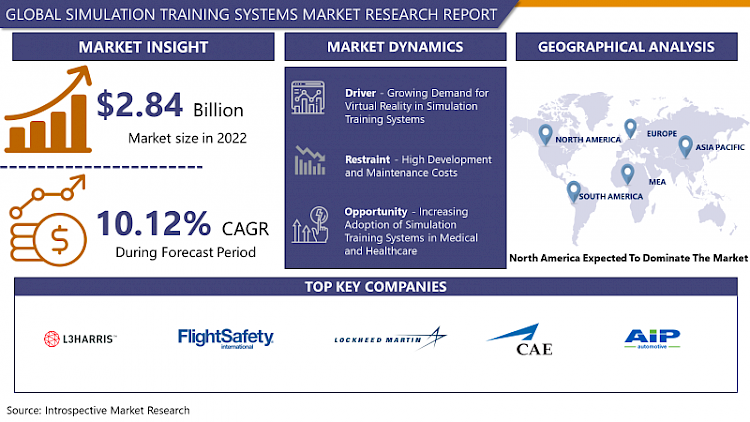Simulation Training Systems Market Synopsis
Global Simulation Training Systems Market Size Was Valued at USD 2.84 Billion in 2022, and is Projected to Reach USD 6.14 Billion by 2030, Growing at a CAGR of 10.12% From 2023-2030.
Simulation training systems are dynamic platforms crafted to mirror real-life situations for training objectives. They employ cutting-edge technologies like virtual reality (VR) and augmented reality (AR) to engage users in realistic environments. These systems facilitate hands-on learning and skill enhancement within a secure and supervised environment, ultimately improving learning results and performance.
- Simulation training systems are utilized across diverse industries, encompassing military, aviation, healthcare, and manufacturing. In the military domain, these systems facilitate combat training, mission rehearsals, and equipment operation simulations. Aviation employs simulation training for pilots to navigate flight scenarios, handle emergencies, and execute aircraft procedures. Healthcare professionals leverage simulation training for surgical practices, patient care, and emergency response protocols. Similarly, manufacturing firms integrate simulation systems for process enhancement, equipment familiarization, and safety procedures.
- The benefits of simulation training systems are multifaceted. they furnish a secure and monitored environment for learners to practice devoid of real-world risks. Secondly, they immerse users in lifelike scenarios, fostering the development of practical skills and decision-making acumen. Furthermore, simulation training encourages iterative practice, enabling users to hone techniques and bolster proficiency over time. Additionally, these systems are adaptable, and tailored to meet specific training objectives and evolving industry demands.
- Future demand for simulation training systems is poised for substantial growth, propelled by various factors. Advancements in technology, including artificial intelligence (AI) and virtual reality (VR), enhance the realism and efficacy of simulation systems. Industries increasingly acknowledge the cost-effectiveness and efficiency of simulation training over traditional methods. As businesses prioritize workforce training and skill development to maintain competitiveness, the demand for simulation training systems is anticipated to ascend steadily in the foreseeable future.
Simulation Training Systems Market Trend Analysis
Growing Demand for Virtual Reality in Simulation Training Systems
- The Burgeoning Demand for Virtual Reality (VR) Technology Is Emerging As A Significant driver for the growth of the simulation training systems market. VR offers immersive and interactive experiences, allowing users to engage with lifelike environments and scenarios. In simulation training systems, VR enhances realism, enabling trainees to undergo training in a highly immersive virtual setting that closely mirrors real-world situations. This heightened sense of realism facilitates more effective learning experiences, as users can practice and refine their skills in a safe and controlled environment.
- Moreover, the versatility of VR technology allows for the creation of diverse training scenarios across various industries, including military, aviation, healthcare, and manufacturing. From combat simulations and flight training to surgical procedures and equipment operation, VR-based simulation training systems cater to a wide range of training needs. As industries increasingly recognize the benefits of immersive training experiences in enhancing learning outcomes and skill development, the demand for simulation training systems incorporating VR technology continues to rise.
- Furthermore, advancements in VR technology, such as improved graphics, haptic feedback, and motion tracking, further enhance the effectiveness and realism of simulation training systems. These technological innovations not only elevate the quality of training experiences but also expand the possibilities for creating more complex and dynamic simulations. As a result, the growing adoption of VR in simulation training systems is expected to drive significant market growth in the coming years, as industries seek innovative solutions to meet their training needs and improve workforce performance.
Increasing Adoption of Simulation Training Systems in Medical and Healthcare
- The rising adoption of simulation training systems within the medical and healthcare fields presents a substantial opportunity for the expansion of the simulation training systems market. Continuous training is imperative for healthcare professionals to refine their skills and proficiency across various medical procedures and patient care practices. Simulation training systems provide a secure and monitored environment for healthcare practitioners to practice surgical techniques, emergency response protocols, and patient care scenarios. Given the increasing emphasis on patient safety and quality care, healthcare institutions are increasingly investing in simulation training systems to ensure their staff is adequately prepared to manage a diverse array of medical situations effectively.
- Moreover, simulation training systems offer healthcare professionals the chance to acquaint themselves with emerging medical technologies and equipment in a controlled setting. Whether it involves mastering the operation of cutting-edge medical devices or honing complex medical procedures, simulation training empowers healthcare workers to gain practical experience and confidence before applying their skills in real-world clinical settings. This not only enhances patient outcomes but also mitigates the risk of medical errors and adverse events, thereby enhancing overall healthcare delivery standards.
- Furthermore, the growing acknowledgment of the efficacy of simulation training in augmenting clinical skills and patient care outcomes is propelling the integration of simulation technology into medical education curricula and professional development initiatives. As medical institutions, hospitals, and healthcare entities increasingly prioritize the incorporation of simulation training systems, the market for these solutions is poised for substantial expansion. With ongoing advancements in simulation technology and the emergence of more immersive and authentic training experiences, the prospects for innovation and growth in the simulation training systems market within the medical and healthcare sectors appear promising.
Simulation Training Systems Market Segment Analysis:
Simulation Training Systems Market Segmented on the basis of Type, Technology, Training Methodology, Application, and End-User.
By Technology, Virtual Reality segment is expected to dominate the market during the forecast period
- The VR segment is positioned to lead the expansion of the simulation training systems market. VR technology delivers immersive and interactive experiences mirroring real-world scenarios, rendering it a prime selection for simulation training across diverse industries. In fields like military, aviation, healthcare, and manufacturing, VR-driven simulation training systems afford trainees lifelike settings to hone skills, tackle intricate tasks, and bolster decision-making proficiencies.
- Various factors contribute to the growing adoption of VR in simulation training systems. Advancements in VR technology have resulted in more cost-effective and accessible VR devices, spurring widespread integration across industries. Furthermore, VR offers advantages such as scalability, adaptability, and cost efficiency, making it an appealing option for organizations seeking to modernize their training initiatives. With businesses increasingly prioritizing immersive and captivating training experiences to enhance learning outcomes and workforce efficiency, the VR segment is anticipated to experience substantial growth within the simulation training systems market in the foreseeable future.
By Application, Military & Defense segment held the largest share of 45.10% in 2022
- The Military & Defense segment has maintained the largest share in the growth of the simulation training systems market. Military and defense entities extensively employ simulation training systems for various purposes, including combat training, mission rehearsals, and equipment operation simulations. These systems allow military personnel to train in realistic environments, thereby enhancing their combat readiness and operational efficiency while mitigating risks associated with live training exercises.
- The dominance of the Military & Defense segment stems from the paramount importance of training in ensuring mission success and personnel safety. Simulation training systems provide a cost-effective and scalable means of delivering lifelike training scenarios, enabling military forces to undergo training across diverse environments and scenarios. Furthermore, advancements in simulation technology, such as virtual reality and augmented reality, have amplified the capabilities of simulation training systems, driving their widespread adoption throughout military and defense organizations worldwide. As defense budgets continue to allocate resources towards training and preparedness endeavors, the Military & Defense segment is poised to sustain its leading position in the simulation training systems market.
Simulation Training Systems Market Regional Insights:
North America is Expected to Dominate the Market Over the Forecast period
- North America is poised to lead the region in the growth of the simulation training systems market. With a strong presence of top simulation training system providers and pioneers in technology, North America has emerged as a leader in adopting cutting-edge training solutions across various sectors. The region benefits from a well-developed infrastructure, a robust focus on technological advancements, and substantial investments in defense, healthcare, aviation, and other crucial industries, which are key drivers of the demand for simulation training systems.
- Furthermore, North America's military and defense sector significantly contributes to the expansion of the simulation training systems market. The United States, with its substantial defense budget and advanced defense capabilities, heavily invests in simulation training systems for its military personnel. Additionally, industries such as aviation, healthcare, and manufacturing in North America prioritize employee training and skill enhancement, further propelling the demand for simulation training systems. As North American businesses continue to prioritize efficiency, safety, and innovative training methods, the region is expected to maintain its dominant stance in the simulation training systems market in the foreseeable future.
Simulation Training Systems Market Top Key Players:
- L3Harris Technologies (U.S.)
- FlightSafety International (U.S.)
- Lockheed Martin (U.S.)
- Boeing (U.S.)
- MTS (U.S.)
- Instron (U.S.)
- Moog Inc. (U.S.)
- CAE, Inc. (Canada)
- AIP GmbH & Co. KG (Germany)
- Bohemia Interactive Simulations (Germany)
- Servotest (UK)
- Thales (France)
- ECA Group (France)
- FAAC (Italy)
- ECA (France)
- RUAG (Switzerland)
- SAGINOMIYA SEISAKUSHO, INC (Japan)
- Elbit Systems (Israel), and Other Major Players
Key Industry Developments in the Simulation Training Systems Market:
- In April 2023, Naval Facilities Engineering Systems Command (NAVFAC) Southeast signed a contract worth USD 41.4 million with the Whiting-Turner Contracting Company for the construction of a Flight Simulator Facility to support the Advanced Helicopter Training System (AHTS) at Naval Air Station in Florida.
- In March 2023, The French Air Force procured a full flight simulator (FFS) for its E-3F airborne warning and control system (AWACS) aircraft. The agreement signed by Air France Industries KLM Engineering & Maintenance (AFI KLM E&M) and Exail to provide the French Air Force with a convenient way to practice and train AWACS capability with a modern domestic flight simulator. The new FFS has an identical setup to the E-3F cockpit to prepare AWACS pilots for realistic scenarios.
|
Global Simulation Training Systems Market |
|||
|
Base Year: |
2022 |
Forecast Period: |
2023-2030 |
|
Historical Data: |
2017 to 2022 |
Market Size in 2022: |
USD 2.84 Bn. |
|
Forecast Period 2023-30 CAGR: |
10.12% |
Market Size in 2030: |
USD 6.14 Bn. |
|
Segments Covered: |
By Type |
|
|
|
By Technology |
|
||
|
By Training Methodology |
|
||
|
By Application |
|
||
|
By End-User |
|
||
|
By Region |
|
||
|
Key Market Drivers: |
|
||
|
Key Market Restraints: |
|
||
|
Key Opportunities: |
|
||
|
Companies Covered in the report: |
|
||
INTRODUCTION
-
- RESEARCH OBJECTIVES
- RESEARCH METHODOLOGY
- RESEARCH PROCESS
- SCOPE AND COVERAGE
- Market Definition
- Key Questions Answered
- MARKET SEGMENTATION
- EXECUTIVE SUMMARY
- MARKET OVERVIEW
- GROWTH OPPORTUNITIES BY SEGMENT
- MARKET LANDSCAPE
- PORTER’S FIVE FORCES ANALYSIS
- Bargaining Power Of Supplier
- Threat Of New Entrants
- Threat Of Substitutes
- Competitive Rivalry
- Bargaining Power Among Buyers
- INDUSTRY VALUE CHAIN ANALYSIS
- MARKET DYNAMICS
- Drivers
- Restraints
- Opportunities
- Challenges
- MARKET TREND ANALYSIS
- REGULATORY LANDSCAPE
- PESTLE ANALYSIS
- PRICE TREND ANALYSIS
- PATENT ANALYSIS
- TECHNOLOGY EVALUATION
- MARKET IMPACT OF THE RUSSIA-UKRAINE WAR
- Geopolitical Market Disruptions
- Supply Chain Disruptions
- Instability in Emerging Markets
- ECOSYSTEM
- PORTER’S FIVE FORCES ANALYSIS
- SIMULATION TRAINING SYSTEMS MARKET BY TYPE (2017-2030)
- SIMULATION TRAINING SYSTEMS MARKET SNAPSHOT AND GROWTH ENGINE
- MARKET OVERVIEW
- VIRTUAL REALITY
- Introduction And Market Overview
- Historic And Forecasted Market Size in Value (2017 – 2030F)
- Historic And Forecasted Market Size in Volume (2017 – 2030F)
- Key Market Trends, Growth Factors And Opportunities
- Geographic Segmentation Analysis
- AUGMENTED REALITY
- MIXED REALITY
- LIVE SIMULATION TRAINING SYSTEMS
- SIMULATION TRAINING SYSTEMS MARKET BY TECHNOLOGY (2017-2030)
- SIMULATION TRAINING SYSTEMS MARKET SNAPSHOT AND GROWTH ENGINE
- MARKET OVERVIEW
- HARDWARE
- Introduction And Market Overview
- Historic And Forecasted Market Size in Value (2017 – 2030F)
- Historic And Forecasted Market Size in Volume (2017 – 2030F)
- Key Market Trends, Growth Factors And Opportunities
- Geographic Segmentation Analysis
- SOFTWARE
- SIMULATION TRAINING SYSTEMS MARKET BY TRAINING METHODOLOGY (2017-2030)
- SIMULATION TRAINING SYSTEMS MARKET SNAPSHOT AND GROWTH ENGINE
- MARKET OVERVIEW
- INSTRUCTOR-LED TRAINING
- Introduction And Market Overview
- Historic And Forecasted Market Size in Value (2017 – 2030F)
- Historic And Forecasted Market Size in Volume (2017 – 2030F)
- Key Market Trends, Growth Factors And Opportunities
- Geographic Segmentation Analysis
- SELF-PACED TRAINING
- BLENDED TRAINING
- SIMULATION TRAINING SYSTEMS MARKET BY APPLICATION (2017-2030)
- SIMULATION TRAINING SYSTEMS MARKET SNAPSHOT AND GROWTH ENGINE
- MARKET OVERVIEW
- MILITARY & DEFENSE
- Introduction And Market Overview
- Historic And Forecasted Market Size in Value (2017 – 2030F)
- Historic And Forecasted Market Size in Volume (2017 – 2030F)
- Key Market Trends, Growth Factors And Opportunities
- Geographic Segmentation Analysis
- CIVILIAN
- INDUSTRIAL
- EDUCATIONAL
- SIMULATION TRAINING SYSTEMS MARKET BY END-USER (2017-2030)
- SIMULATION TRAINING SYSTEMS MARKET SNAPSHOT AND GROWTH ENGINE
- MARKET OVERVIEW
- GOVERNMENT
- Introduction And Market Overview
- Historic And Forecasted Market Size in Value (2017 – 2030F)
- Historic And Forecasted Market Size in Volume (2017 – 2030F)
- Key Market Trends, Growth Factors And Opportunities
- Geographic Segmentation Analysis
- COMMERCIAL
- ACADEMIC
- COMPANY PROFILES AND COMPETITIVE ANALYSIS
- COMPETITIVE LANDSCAPE
- Competitive Positioning
- Simulation Training Systems Market Share By Manufacturer (2022)
- Industry BCG Matrix
- Heat Map Analysis
- Mergers & Acquisitions
- L3HARRIS TECHNOLOGIES (U.S.)
- Company Overview
- Key Executives
- Company Snapshot
- Role of the Company in the Market
- Sustainability and Social Responsibility
- Operating Business Segments
- Product Portfolio
- Business Performance (Production Volume, Sales Volume, Sales Margin, Production Capacity, Capacity Utilization Rate)
- Key Strategic Moves And Recent Developments
- SWOT Analysis
- FLIGHTSAFETY INTERNATIONAL (U.S.)
- LOCKHEED MARTIN (U.S.)
- BOEING (U.S.)
- MTS (U.S.)
- INSTRON (U.S.)
- MOOG INC. (U.S.)
- CAE, INC. (CANADA)
- AIP GMBH & CO. KG (GERMANY)
- BOHEMIA INTERACTIVE SIMULATIONS (GERMANY)
- SERVOTEST (UK)
- THALES (FRANCE)
- ECA GROUP (FRANCE)
- FAAC (ITALY)
- ECA (FRANCE)
- RUAG (SWITZERLAND)
- SAGINOMIYA SEISAKUSHO, INC (JAPAN)
- ELBIT SYSTEMS (ISRAEL)
- COMPETITIVE LANDSCAPE
- GLOBAL SIMULATION TRAINING SYSTEMS MARKET BY REGION
- OVERVIEW
- NORTH AMERICA
- Key Market Trends, Growth Factors And Opportunities
- Key Manufacturers
- Historic And Forecasted Market Size By Type
- Historic And Forecasted Market Size By Technology
- Historic And Forecasted Market Size By Training Methodology
- Historic And Forecasted Market Size By Application
- Historic And Forecasted Market Size By End-User
- Historic And Forecasted Market Size By Country
- USA
- Canada
- Mexico
- EASTERN EUROPE
- Key Market Trends, Growth Factors And Opportunities
- Key Manufacturers
- Historic And Forecasted Market Size By Segments
- Historic And Forecasted Market Size By Country
- Russia
- Bulgaria
- The Czech Republic
- Hungary
- Poland
- Romania
- Rest Of Eastern Europe
- WESTERN EUROPE
- Key Market Trends, Growth Factors And Opportunities
- Key Manufacturers
- Historic And Forecasted Market Size By Segments
- Historic And Forecasted Market Size By Country
- Germany
- United Kingdom
- France
- The Netherlands
- Italy
- Spain
- Rest Of Western Europe
- ASIA PACIFIC
- Key Market Trends, Growth Factors And Opportunities
- Key Manufacturers
- Historic And Forecasted Market Size By Segments
- Historic And Forecasted Market Size By Country
- China
- India
- Japan
- South Korea
- Malaysia
- Thailand
- Vietnam
- The Philippines
- Australia
- New-Zealand
- Rest Of APAC
- MIDDLE EAST & AFRICA
- Key Market Trends, Growth Factors And Opportunities
- Key Manufacturers
- Historic And Forecasted Market Size By Segments
- Historic And Forecasted Market Size By Country
- Turkey
- Bahrain
- Kuwait
- Saudi Arabia
- Qatar
- UAE
- Israel
- South Africa
- SOUTH AMERICA
- Key Market Trends, Growth Factors And Opportunities
- Key Manufacturers
- Historic And Forecasted Market Size By Segments
- Historic And Forecasted Market Size By Country
- Brazil
- Argentina
- Rest of South America
- INVESTMENT ANALYSIS
- ANALYST VIEWPOINT AND CONCLUSION
- Recommendations and Concluding Analysis
- Potential Market Strategies
|
Global Simulation Training Systems Market |
|||
|
Base Year: |
2022 |
Forecast Period: |
2023-2030 |
|
Historical Data: |
2017 to 2022 |
Market Size in 2022: |
USD 2.84 Bn. |
|
Forecast Period 2023-30 CAGR: |
10.12% |
Market Size in 2030: |
USD 6.14 Bn. |
|
Segments Covered: |
By Type |
|
|
|
By Technology |
|
||
|
By Training Methodology |
|
||
|
By Application |
|
||
|
By End-User |
|
||
|
By Region |
|
||
|
Key Market Drivers: |
|
||
|
Key Market Restraints: |
|
||
|
Key Opportunities: |
|
||
|
Companies Covered in the report: |
|
||
LIST OF TABLES
TABLE 001. EXECUTIVE SUMMARY
TABLE 002. SIMULATION TRAINING SYSTEMS MARKET BARGAINING POWER OF SUPPLIERS
TABLE 003. SIMULATION TRAINING SYSTEMS MARKET BARGAINING POWER OF CUSTOMERS
TABLE 004. SIMULATION TRAINING SYSTEMS MARKET COMPETITIVE RIVALRY
TABLE 005. SIMULATION TRAINING SYSTEMS MARKET THREAT OF NEW ENTRANTS
TABLE 006. SIMULATION TRAINING SYSTEMS MARKET THREAT OF SUBSTITUTES
TABLE 007. SIMULATION TRAINING SYSTEMS MARKET BY TYPE
TABLE 008. INITIAL DRIVING TRAINING MARKET OVERVIEW (2016-2028)
TABLE 009. ADVANCED DRIVING TRAINING MARKET OVERVIEW (2016-2028)
TABLE 010. SIMULATION TRAINING SYSTEMS MARKET BY APPLICATION
TABLE 011. CAR MARKET OVERVIEW (2016-2028)
TABLE 012. TRUCK MARKET OVERVIEW (2016-2028)
TABLE 013. BUS MARKET OVERVIEW (2016-2028)
TABLE 014. MOTORCYCLE MARKET OVERVIEW (2016-2028)
TABLE 015. OTHERS MARKET OVERVIEW (2016-2028)
TABLE 016. NORTH AMERICA SIMULATION TRAINING SYSTEMS MARKET, BY TYPE (2016-2028)
TABLE 017. NORTH AMERICA SIMULATION TRAINING SYSTEMS MARKET, BY APPLICATION (2016-2028)
TABLE 018. N SIMULATION TRAINING SYSTEMS MARKET, BY COUNTRY (2016-2028)
TABLE 019. EUROPE SIMULATION TRAINING SYSTEMS MARKET, BY TYPE (2016-2028)
TABLE 020. EUROPE SIMULATION TRAINING SYSTEMS MARKET, BY APPLICATION (2016-2028)
TABLE 021. SIMULATION TRAINING SYSTEMS MARKET, BY COUNTRY (2016-2028)
TABLE 022. ASIA PACIFIC SIMULATION TRAINING SYSTEMS MARKET, BY TYPE (2016-2028)
TABLE 023. ASIA PACIFIC SIMULATION TRAINING SYSTEMS MARKET, BY APPLICATION (2016-2028)
TABLE 024. SIMULATION TRAINING SYSTEMS MARKET, BY COUNTRY (2016-2028)
TABLE 025. MIDDLE EAST & AFRICA SIMULATION TRAINING SYSTEMS MARKET, BY TYPE (2016-2028)
TABLE 026. MIDDLE EAST & AFRICA SIMULATION TRAINING SYSTEMS MARKET, BY APPLICATION (2016-2028)
TABLE 027. SIMULATION TRAINING SYSTEMS MARKET, BY COUNTRY (2016-2028)
TABLE 028. SOUTH AMERICA SIMULATION TRAINING SYSTEMS MARKET, BY TYPE (2016-2028)
TABLE 029. SOUTH AMERICA SIMULATION TRAINING SYSTEMS MARKET, BY APPLICATION (2016-2028)
TABLE 030. SIMULATION TRAINING SYSTEMS MARKET, BY COUNTRY (2016-2028)
TABLE 031. ECA GROUP: SNAPSHOT
TABLE 032. ECA GROUP: BUSINESS PERFORMANCE
TABLE 033. ECA GROUP: PRODUCT PORTFOLIO
TABLE 034. ECA GROUP: KEY STRATEGIC MOVES AND DEVELOPMENTS
TABLE 034. AIP GMBH: SNAPSHOT
TABLE 035. AIP GMBH: BUSINESS PERFORMANCE
TABLE 036. AIP GMBH: PRODUCT PORTFOLIO
TABLE 037. AIP GMBH: KEY STRATEGIC MOVES AND DEVELOPMENTS
TABLE 037. MTS: SNAPSHOT
TABLE 038. MTS: BUSINESS PERFORMANCE
TABLE 039. MTS: PRODUCT PORTFOLIO
TABLE 040. MTS: KEY STRATEGIC MOVES AND DEVELOPMENTS
TABLE 040. INSTRON: SNAPSHOT
TABLE 041. INSTRON: BUSINESS PERFORMANCE
TABLE 042. INSTRON: PRODUCT PORTFOLIO
TABLE 043. INSTRON: KEY STRATEGIC MOVES AND DEVELOPMENTS
TABLE 043. KNR SYSTEM: SNAPSHOT
TABLE 044. KNR SYSTEM: BUSINESS PERFORMANCE
TABLE 045. KNR SYSTEM: PRODUCT PORTFOLIO
TABLE 046. KNR SYSTEM: KEY STRATEGIC MOVES AND DEVELOPMENTS
TABLE 046. MOOG INC: SNAPSHOT
TABLE 047. MOOG INC: BUSINESS PERFORMANCE
TABLE 048. MOOG INC: PRODUCT PORTFOLIO
TABLE 049. MOOG INC: KEY STRATEGIC MOVES AND DEVELOPMENTS
TABLE 049. SHORE WESTERN: SNAPSHOT
TABLE 050. SHORE WESTERN: BUSINESS PERFORMANCE
TABLE 051. SHORE WESTERN: PRODUCT PORTFOLIO
TABLE 052. SHORE WESTERN: KEY STRATEGIC MOVES AND DEVELOPMENTS
TABLE 052. SERVOTEST: SNAPSHOT
TABLE 053. SERVOTEST: BUSINESS PERFORMANCE
TABLE 054. SERVOTEST: PRODUCT PORTFOLIO
TABLE 055. SERVOTEST: KEY STRATEGIC MOVES AND DEVELOPMENTS
TABLE 055. BURKE E. PORTER MACHINERY: SNAPSHOT
TABLE 056. BURKE E. PORTER MACHINERY: BUSINESS PERFORMANCE
TABLE 057. BURKE E. PORTER MACHINERY: PRODUCT PORTFOLIO
TABLE 058. BURKE E. PORTER MACHINERY: KEY STRATEGIC MOVES AND DEVELOPMENTS
TABLE 058. AIP AUTOMOTIVE: SNAPSHOT
TABLE 059. AIP AUTOMOTIVE: BUSINESS PERFORMANCE
TABLE 060. AIP AUTOMOTIVE: PRODUCT PORTFOLIO
TABLE 061. AIP AUTOMOTIVE: KEY STRATEGIC MOVES AND DEVELOPMENTS
TABLE 061. BIA: SNAPSHOT
TABLE 062. BIA: BUSINESS PERFORMANCE
TABLE 063. BIA: PRODUCT PORTFOLIO
TABLE 064. BIA: KEY STRATEGIC MOVES AND DEVELOPMENTS
TABLE 064. HOFMANN TESYS: SNAPSHOT
TABLE 065. HOFMANN TESYS: BUSINESS PERFORMANCE
TABLE 066. HOFMANN TESYS: PRODUCT PORTFOLIO
TABLE 067. HOFMANN TESYS: KEY STRATEGIC MOVES AND DEVELOPMENTS
TABLE 067. ELEMENT: SNAPSHOT
TABLE 068. ELEMENT: BUSINESS PERFORMANCE
TABLE 069. ELEMENT: PRODUCT PORTFOLIO
TABLE 070. ELEMENT: KEY STRATEGIC MOVES AND DEVELOPMENTS
TABLE 070. SAGINOMIYA SEISAKUSHO: SNAPSHOT
TABLE 071. SAGINOMIYA SEISAKUSHO: BUSINESS PERFORMANCE
TABLE 072. SAGINOMIYA SEISAKUSHO: PRODUCT PORTFOLIO
TABLE 073. SAGINOMIYA SEISAKUSHO: KEY STRATEGIC MOVES AND DEVELOPMENTS
LIST OF FIGURES
FIGURE 001. YEARS CONSIDERED FOR ANALYSIS
FIGURE 002. SCOPE OF THE STUDY
FIGURE 003. SIMULATION TRAINING SYSTEMS MARKET OVERVIEW BY REGIONS
FIGURE 004. PORTER'S FIVE FORCES ANALYSIS
FIGURE 005. BARGAINING POWER OF SUPPLIERS
FIGURE 006. COMPETITIVE RIVALRYFIGURE 007. THREAT OF NEW ENTRANTS
FIGURE 008. THREAT OF SUBSTITUTES
FIGURE 009. VALUE CHAIN ANALYSIS
FIGURE 010. PESTLE ANALYSIS
FIGURE 011. SIMULATION TRAINING SYSTEMS MARKET OVERVIEW BY TYPE
FIGURE 012. INITIAL DRIVING TRAINING MARKET OVERVIEW (2016-2028)
FIGURE 013. ADVANCED DRIVING TRAINING MARKET OVERVIEW (2016-2028)
FIGURE 014. SIMULATION TRAINING SYSTEMS MARKET OVERVIEW BY APPLICATION
FIGURE 015. CAR MARKET OVERVIEW (2016-2028)
FIGURE 016. TRUCK MARKET OVERVIEW (2016-2028)
FIGURE 017. BUS MARKET OVERVIEW (2016-2028)
FIGURE 018. MOTORCYCLE MARKET OVERVIEW (2016-2028)
FIGURE 019. OTHERS MARKET OVERVIEW (2016-2028)
FIGURE 020. NORTH AMERICA SIMULATION TRAINING SYSTEMS MARKET OVERVIEW BY COUNTRY (2016-2028)
FIGURE 021. EUROPE SIMULATION TRAINING SYSTEMS MARKET OVERVIEW BY COUNTRY (2016-2028)
FIGURE 022. ASIA PACIFIC SIMULATION TRAINING SYSTEMS MARKET OVERVIEW BY COUNTRY (2016-2028)
FIGURE 023. MIDDLE EAST & AFRICA SIMULATION TRAINING SYSTEMS MARKET OVERVIEW BY COUNTRY (2016-2028)
FIGURE 024. SOUTH AMERICA SIMULATION TRAINING SYSTEMS MARKET OVERVIEW BY COUNTRY (2016-2028)
Frequently Asked Questions :
The forecast period in the Simulation Training Systems Market research report is 2023-2030.
L3Harris Technologies (U.S.), FlightSafety International (U.S.), Lockheed Martin (U.S.), Boeing (U.S.), MTS (U.S.), Instron (U.S.), Moog Inc. (U.S.), CAE, Inc. (Canada), AIP GmbH & Co. KG (Germany), Bohemia Interactive Simulations (Germany), Servotest (UK), Thales (France), ECA Group (France), FAAC (Italy), ECA (France), RUAG (Switzerland), Saginomiya Seisakusho, INC (Japan), Elbit Systems (Israel), and Other Major Players.
The Simulation Training Systems Market is segmented into Type, Technology, Training Methodology, Application, End-User, and Region. By Type, the market is categorized into Virtual Reality, Augmented Reality, Mixed Reality, and Live Simulation Training Systems. By Technology, the market is categorized into Hardware and software. By Training Methodology, the market is categorized into Instructor-Led Training, Self-Paced Training, and Blended Training. By Application, the market is categorized into Military & Defense, Civilian, Industrial, and Educational. By End-User, the market is categorized into Government, Commercial, and Academic. By region, it is analyzed across North America (U.S.; Canada; Mexico), Eastern Europe (Bulgaria; The Czech Republic; Hungary; Poland; Romania; Rest of Eastern Europe), Western Europe (Germany; UK; France; Netherlands; Italy; Russia; Spain; Rest of Western Europe), Asia-Pacific (China; India; Japan; Southeast Asia, etc.), South America (Brazil; Argentina, etc.), Middle East & Africa (Saudi Arabia; South Africa, etc.).
Simulation training systems are dynamic platforms crafted to mirror real-life situations for training objectives. They employ cutting-edge technologies like virtual reality (VR) and augmented reality (AR) to engage users in realistic environments. These systems facilitate hands-on learning and skill enhancement within a secure and supervised environment, ultimately improving learning results and performance.
Global Simulation Training Systems Market Size Was Valued at USD 2.84 Billion in 2022, and is Projected to Reach USD 6.14 Billion by 2030, Growing at a CAGR of 10.12% From 2023-2030.



































